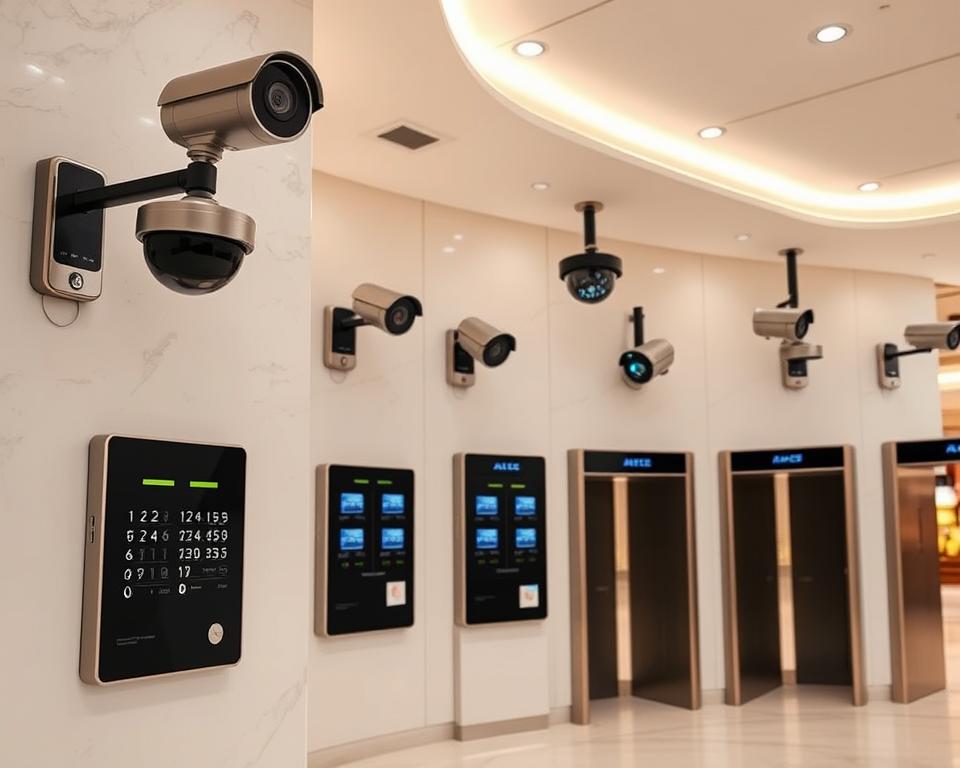Improving Your Safety through Mall Security Measures
Imagine if the secret to safer shopping wasn’t just cameras and guards? As crowds grow and risks evolve, protected environments need more than standard methods. Contemporary safety concerns demand thoughtful tactics blending human know-how with high-tech tools.
In light of increasing public safety worries, businesses now prioritize robust protection systems. Divine Protection Services leads this shift, merging strict training with advanced tools to define industry benchmarks. Their approach focuses on proactive construction security guards measures rather than reactive responses.
Well-trained security personnel are key to maintaining order. They observe bustling areas, manage crisis situations, and create trust through their visible presence. This people-first philosophy ensures both shoppers and employees feel protected during every visit.
Subsequent parts will show how surveillance improvements and access controls establish smooth security networks. Learn how strategic planning turns malls into safe havens while driving business growth.
Grasping the Need for Mall Security
Developing safe environments for patrons and staff demands more than mere patrols. Modern protection programs rely on layered approaches that combine technology, training, and teamwork. These setups do more than react to issues—they avert them.

How Surveillance and Access Control Operate
HD cameras and intelligent entry systems form the core of contemporary safety plans. Carefully located sensors oversee crowded areas like entryways and parking spaces. This structure enables teams to identify irregular activity promptly.
Entry management tools restrict access to off-limits zones while allowing shoppers to roam freely through stores. Routine equipment inspections make sure cameras and scanners operate perfectly. Real-time monitoring allows teams to act before little problems escalate.
Security, Reputation, and Client Experience
Experienced officers do more than stare at screens—they guide lost visitors and resolve conflicts. Their presence comforts customers, fostering longer stays and return visits. A single event can erode trust, making prevention essential.
Backing continuous staff training guarantees teams tackle medical emergencies or crowd surges competently. When protective actions mesh with daily workflows, firms flourish in safer environments.
Divine Protection Services: Your Ally in Mall Safety
When protection is essential, firms need partners who offer more than guarantees. Divine Protection Services stands out by blending advanced tools with skilled personnel to address modern risks. Their strategies adapt to evolving challenges while maintaining a welcoming atmosphere for visitors.
Our Comprehensive Security Approach
This firm merges three pillars for peak effectiveness:
- Advanced surveillance networks overseeing crowded zones
- Entry management systems that limit access without hindering foot traffic
- Routine equipment updates guaranteeing stable performance
Their staff leverages real-time data to detect odd patterns, from abandoned bags to unapproved entries. This proactive method prevents issues before they escalate, keeping public spaces secure yet accessible.
Enabling Security Officers with Training and Support
Divine Protection Services commits significant investment to skill development. Guards receive:
- BST certification for managing aggressive situations
- First aid preparation for medical crises
- Customer service seminars boosting visitor interactions
Ongoing development opportunities guarantee teams are equipped for different scenarios. “Our team members aren’t just guards—they’re safety ambassadors,” mentions a company spokeswoman. This focus on growth fosters confidence in both personnel and shoppers, creating environments where everyone thrives.
Training, Certifications, and Personnel Excellence in Security
Supporting security guards starts with more than just a uniform—it demands comprehensive preparation. Staff succeed when endowed with certifications and experiential training geared to modern challenges. This groundwork transforms daily interactions into chances to foster trust and avert incidents.
Core Training Programs and Certifications
Security staff initiate with three principal certifications: BST for conflict resolution, first aid for medical crises, and non-violent intervention strategies. These capabilities assist in calming tense situations while prioritizing guest safety. Frequent sessions update these skills, ensuring teams adapt to evolving threats.
Scenario-based exercises mimic real-world events like crowd surges or displaced children. Online modules cover evolving trends, from digital scanning tools to accessibility guidelines. “Training never stops—it evolves,” explains a Divine Protection Services instructor. This method keeps teams prepared for both standard duties and sudden alarms.
Establishing a People-First Culture in Security
Ongoing education nurtures empathy and problem-solving skills essential for public areas. Guards schooled in customer service guide shoppers with directions or store suggestions, combining safety with hospitality. This twin emphasis forms hospitable environments where people feel valued.
Divine Protection Services reinforces this culture through mentorship programs and equipment mastery sessions. Confident, well-supported teams reduce risks while strengthening community relationships. The outcome? More secure shopping areas where staff and patrons alike can concentrate on priorities.
Mall Security: Guidelines for a Secure Shopping Environment
How do crowded malls merge safety with smooth visitor experiences? The solution is melding vigilant technology with friendly personnel. Modern strategies focus on preventing issues while maintaining welcoming atmospheres.
Boosting Visibility via Technology
High-def cameras now monitor crucial areas like parking garages and food courts. These networks utilize motion detection to spot unusual behavior, such as abandoned packages or erratic movements. Consolidated dashboards enable teams to monitor multiple areas simultaneously.
Periodic upkeep tests confirm sensors and alarms work without issues. “Our weekly system checks stop 90% of likely malfunctions,” notes a retail safety manager. Integrating live video with AI analysis helps identify patterns human eyes might miss.
Merging Safety With Hospitality
Well-trained officers often double as information guides. They help with store directions, missing items, and parking questions. This double role nurtures trust while guaranteeing security.
Entry management tools like smart turnstiles limit access to staff areas without slowing foot traffic. Hue-coded badges allow swift recognition of authorized staff. At busy times, temporary checkpoints control crowd movement near busy stores.
Monthly group meetings between teams confirm everyone is aware of emergency protocols. Small changes—like improved lighting near restrooms—can ward off incidents while enhancing visitor comfort. When technology and collaboration unite, public areas become more secure and enjoyable.
Handling Emergencies and Crowds in Shopping Malls
When seconds count, how do crowded spaces transform chaos into order? Effective emergency plans blend clear protocols with practiced teamwork. Preparation transforms possible disasters into controllable scenarios where everyone understands their role.
Agile Emergency Management Techniques
Preset action plans are essential in emergencies. Crews use color-coded signals to mark different threat levels—red for fires, yellow for medical issues. This system helps personnel react swiftly without confusion.
Primary strategies encompass:
- Assigned evacuation pathways marked with glow-in-the-dark signs
- Real-time communication via encrypted earpieces
- Automatic lockdown functions for off-limit zones
Officers trained in crowd psychology guide patrons using calm verbal cues and visual signals. “We conduct疏散 drills monthly to maintain instinctive responses,” shares a retail safety coordinator. Camera feeds help recognize bottlenecks, enabling teams to reroute traffic before panic spreads.
Local fire brigades obtain live updates via integrated systems during incidents. Cooperative training drills guarantee smooth teamwork. Post-action evaluations highlight areas for improvement, like swifter first aid deployment.
One Midwest shopping center lowered evacuation times by 40% after enhancing their PA network. Ongoing updates to response protocols ensure teams tackle new challenges while sustaining visitor confidence.
Technology Innovations and Upcoming Trends in Mall Security
Imagine walking into a space where safety systems anticipate risks before they happen. Leading-edge developments are altering how public venues protect visitors while improving convenience. From AI-powered analytics to biometric scanners, future solutions merge accuracy with smooth operation.
Smart Systems for Proactive Protection
Machine learning now processes camera feeds to spot anomalous behavior, like abandoned bags or erratic movements. These tools signal potential dangers faster than manual monitoring. Predictive models scrutinize historical data to forecast peak traffic moments, guiding teams in allocating resources effectively.
High-tech access systems employ facial recognition to permit entry to restricted zones. “Biometric tech reduces unauthorized access by 78%,” notes a retail safety expert. Instant dashboards present crowd density analytics, enabling officers to redirect foot traffic before bottlenecks emerge.
Training programs now incorporate virtual reality simulations. Security officers train on managing scenarios from medical emergencies to active threats. This hands-on approach builds muscle memory for high-pressure situations.
Future trends point to drone patrols for parking lots and IoT-connected sensors detecting environmental hazards. As tech evolves, shoppers enjoy smoother visits while feeling safeguarded. Businesses adopting these tools stay ahead in creating spaces where safety and satisfaction grow hand-in-hand.
Conclusion: Improving Mall Safety with Confidence
Creating safer mall environments begins with trust in both planning and execution. Divine Protection Services spearheads this effort by merging AI tools with expertly trained personnel. Their approach transforms standard protocols into dynamic systems that adapt to evolving challenges.
Modern safety thrives on three pillars: real-time surveillance, precise access control, and rapid emergency response. Squads leveraging predictive analytics can detect risks before they intensify, while customer-centric officers ensure seamless operations. This mix of technology and humanity builds areas where visitors feel safe yet free to wander.
Allocating to continual upgrades guarantees long-term success. From biometric scanners to crowd management algorithms, innovation keeps properties ahead of threats. Partnering with experts like Divine Protection Services guarantees tailored solutions that grow with your needs.
Geared up to improve your safety standards? Explore how cutting-edge systems and compassionate service can transform your space. Peace of mind begins with proactive partnerships—make the move to a safer future today.
FAQ
How does access control raise safety in public areas?
Access control confines entry points, diminishes unauthorized access, and enables teams to supervise foot traffic. Tools such as keycard readers or biometric scanners guarantee only authorized visitors enter restricted areas, providing a safer environment for all.
Which certifications are required for security officers?
Security personnel should obtain certifications like CPR/First Aid, crisis intervention training (CIT), and state-authorized licensing. Courses like ASP baton training or de-escalation seminars also equip teams to manage high-pressure scenarios effectively.
How do surveillance systems adjust to large crowds?
Cutting-edge systems utilize AI-based cameras to observe movement patterns and flag anomalies. In busy times, live feeds assist teams in rerouting foot traffic, handling bottlenecks, and reacting rapidly to incidents without disturbing shoppers.
Why is customer service essential for security personnel?
Friendly interactions build trust and encourage patrons to report concerns. Guards skilled in communication can help with directions, lost items, or small conflicts, boosting the overall experience while staying vigilant.
How does technology contribute to emergency response?
Devices like panic buttons, live communication apps, and unified alarm systems enable teams to coordinate more rapidly. For example, automated notifications can lock down areas or direct evacuations in critical situations.
How does Divine Protection Services aid its teams?
They offer continual training, high-tech tools such as body cameras, and constant operational backup. Consistent drills and access to industry specialists guarantee officers stay equipped for changing challenges in public spaces.
Can AI reduce risks in retail environments?
Yes! Machine learning analyzes data to predict hotspots for theft or accidents. Cameras using facial recognition or plate scanning likewise help spot repeat offenders before problems intensify.
What approaches prevent conflicts during busy seasons?
Clear signage, designated rest zones, and staggered entry points ease congestion. Security officers proficient in crowd control utilize non-confrontational approaches to defuse tensions and maintain order.


